Organizational Development and Change Management: A Case Study Report
VerifiedAdded on 2020/03/28
|10
|1749
|68
Report
AI Summary
This report examines organizational development and change management through the lens of a case study, focusing on the implementation of technological change within a company. It identifies major sources of resistance to change, including employee reluctance, confusion, and the role of unions and past change failures. The report explores strategies for managing resistance, such as prior preparation and effective communication, and analyzes the crucial role of leadership in guiding the change process. Furthermore, it discusses the contributions of consultants in facilitating change, including organizational structure modification and employee training. The conclusion highlights the need for improved cooperation between management and employees to successfully navigate organizational change, offering insights into overcoming resistance and implementing change effectively. The report also provides a comparative analysis with another case study, enriching the understanding of the topic.
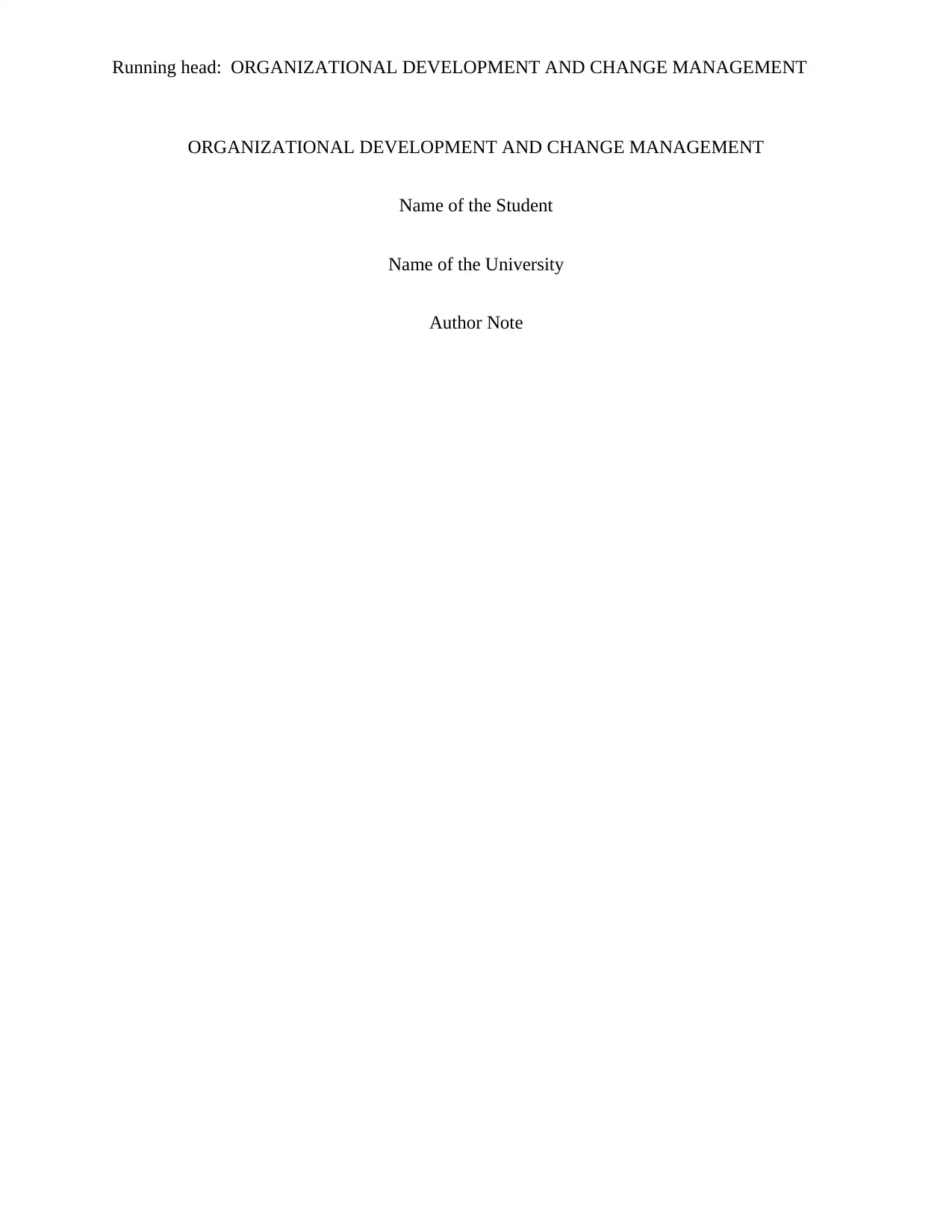
Running head: ORGANIZATIONAL DEVELOPMENT AND CHANGE MANAGEMENT
ORGANIZATIONAL DEVELOPMENT AND CHANGE MANAGEMENT
Name of the Student
Name of the University
Author Note
ORGANIZATIONAL DEVELOPMENT AND CHANGE MANAGEMENT
Name of the Student
Name of the University
Author Note
Paraphrase This Document
Need a fresh take? Get an instant paraphrase of this document with our AI Paraphraser
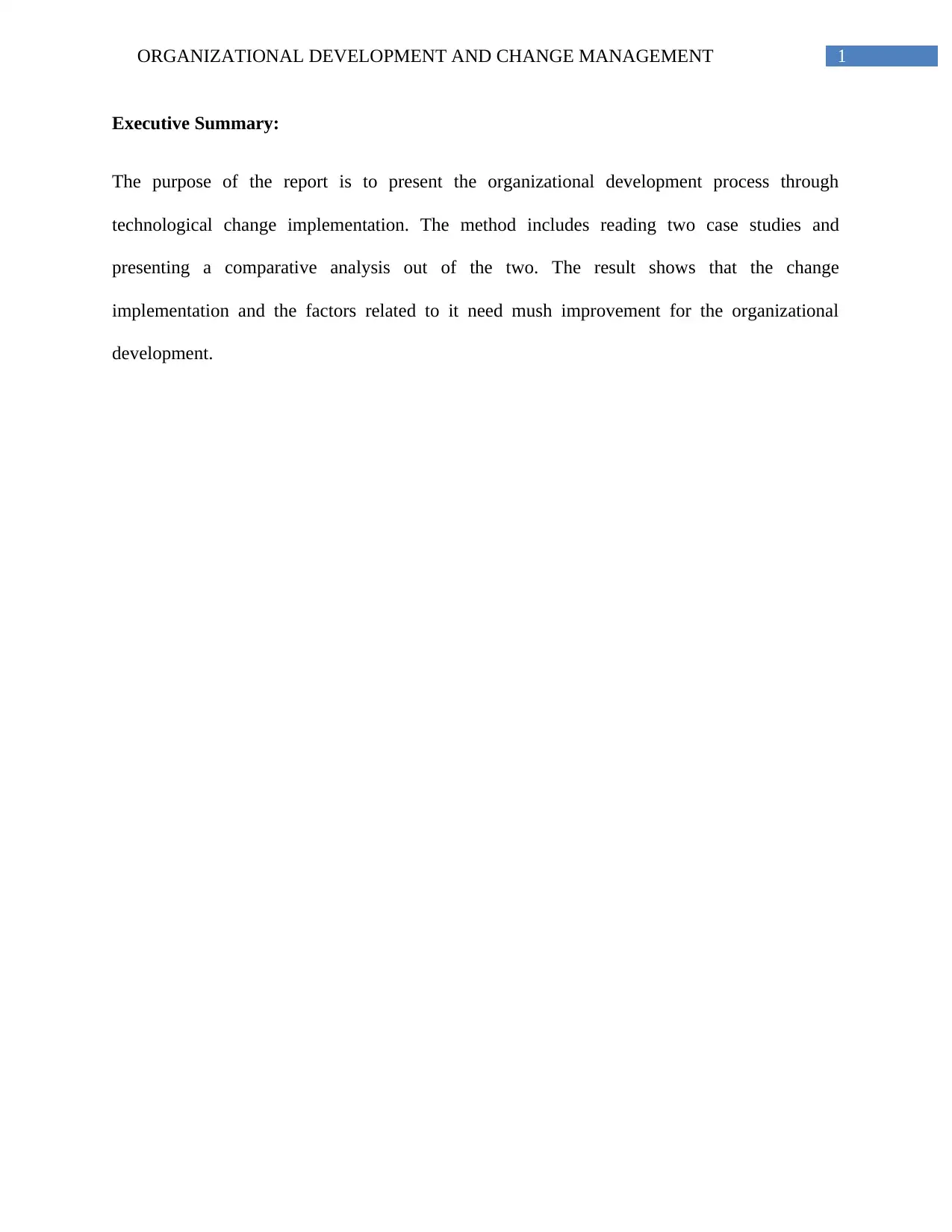
1ORGANIZATIONAL DEVELOPMENT AND CHANGE MANAGEMENT
Executive Summary:
The purpose of the report is to present the organizational development process through
technological change implementation. The method includes reading two case studies and
presenting a comparative analysis out of the two. The result shows that the change
implementation and the factors related to it need mush improvement for the organizational
development.
Executive Summary:
The purpose of the report is to present the organizational development process through
technological change implementation. The method includes reading two case studies and
presenting a comparative analysis out of the two. The result shows that the change
implementation and the factors related to it need mush improvement for the organizational
development.
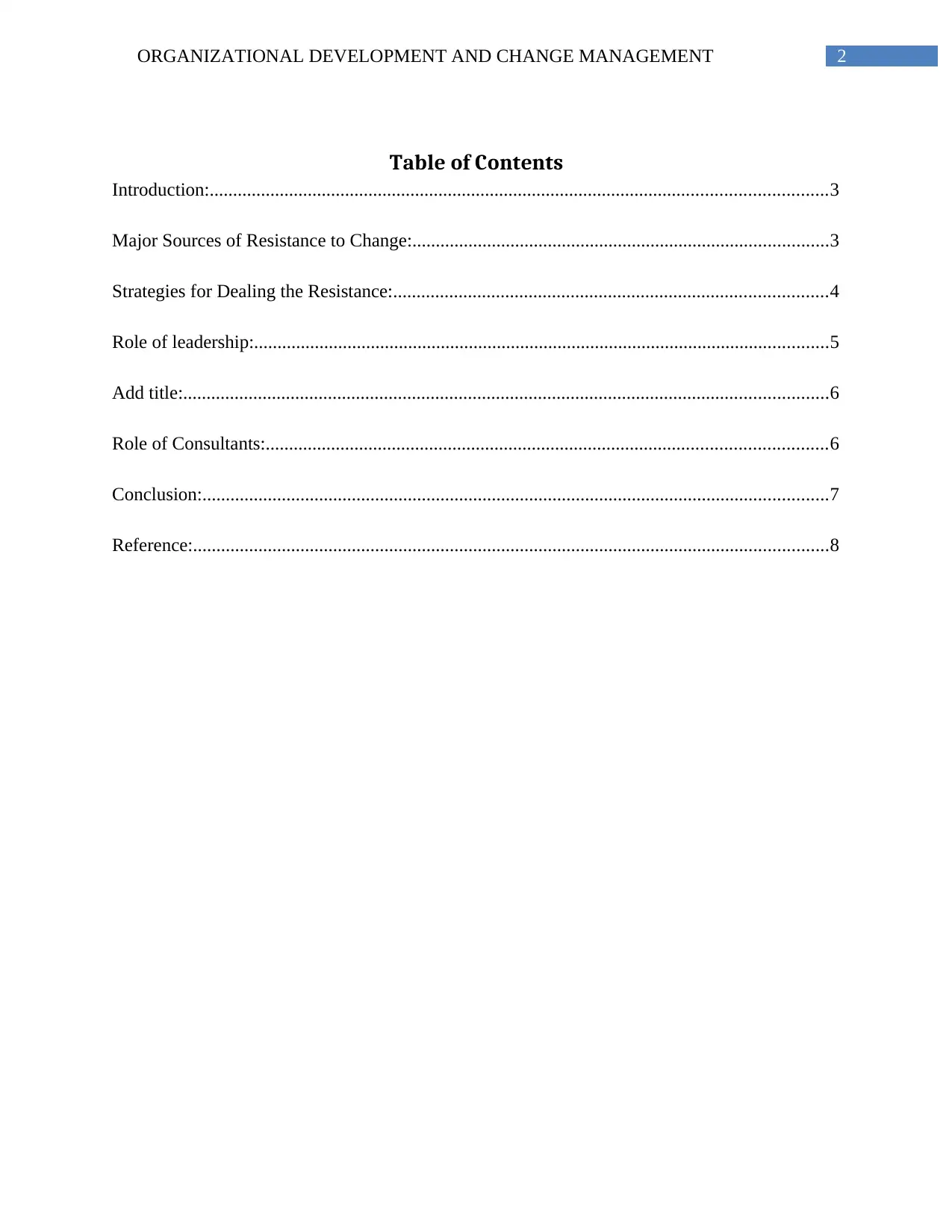
2ORGANIZATIONAL DEVELOPMENT AND CHANGE MANAGEMENT
Table of Contents
Introduction:....................................................................................................................................3
Major Sources of Resistance to Change:.........................................................................................3
Strategies for Dealing the Resistance:.............................................................................................4
Role of leadership:...........................................................................................................................5
Add title:..........................................................................................................................................6
Role of Consultants:........................................................................................................................6
Conclusion:......................................................................................................................................7
Reference:........................................................................................................................................8
Table of Contents
Introduction:....................................................................................................................................3
Major Sources of Resistance to Change:.........................................................................................3
Strategies for Dealing the Resistance:.............................................................................................4
Role of leadership:...........................................................................................................................5
Add title:..........................................................................................................................................6
Role of Consultants:........................................................................................................................6
Conclusion:......................................................................................................................................7
Reference:........................................................................................................................................8
⊘ This is a preview!⊘
Do you want full access?
Subscribe today to unlock all pages.

Trusted by 1+ million students worldwide
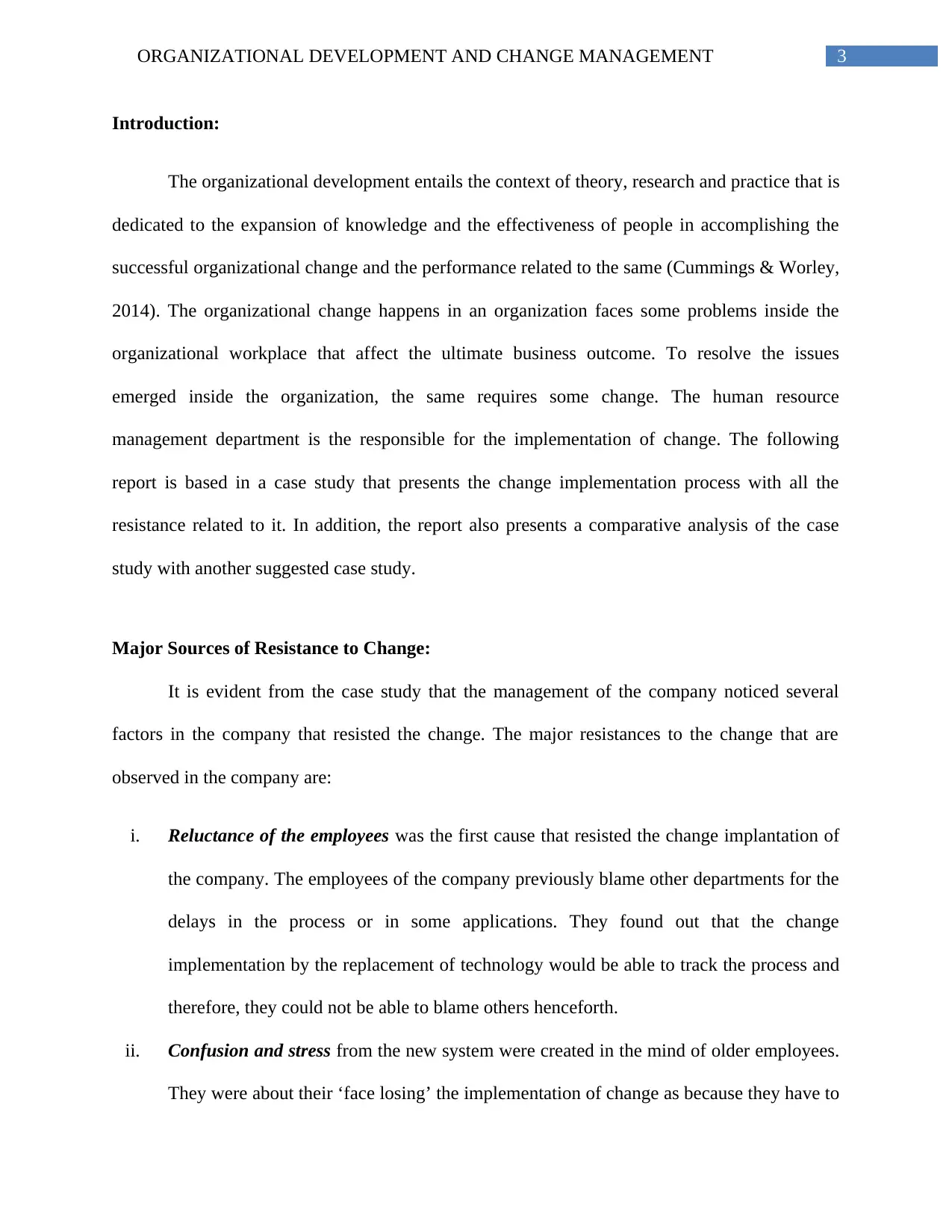
3ORGANIZATIONAL DEVELOPMENT AND CHANGE MANAGEMENT
Introduction:
The organizational development entails the context of theory, research and practice that is
dedicated to the expansion of knowledge and the effectiveness of people in accomplishing the
successful organizational change and the performance related to the same (Cummings & Worley,
2014). The organizational change happens in an organization faces some problems inside the
organizational workplace that affect the ultimate business outcome. To resolve the issues
emerged inside the organization, the same requires some change. The human resource
management department is the responsible for the implementation of change. The following
report is based in a case study that presents the change implementation process with all the
resistance related to it. In addition, the report also presents a comparative analysis of the case
study with another suggested case study.
Major Sources of Resistance to Change:
It is evident from the case study that the management of the company noticed several
factors in the company that resisted the change. The major resistances to the change that are
observed in the company are:
i. Reluctance of the employees was the first cause that resisted the change implantation of
the company. The employees of the company previously blame other departments for the
delays in the process or in some applications. They found out that the change
implementation by the replacement of technology would be able to track the process and
therefore, they could not be able to blame others henceforth.
ii. Confusion and stress from the new system were created in the mind of older employees.
They were about their ‘face losing’ the implementation of change as because they have to
Introduction:
The organizational development entails the context of theory, research and practice that is
dedicated to the expansion of knowledge and the effectiveness of people in accomplishing the
successful organizational change and the performance related to the same (Cummings & Worley,
2014). The organizational change happens in an organization faces some problems inside the
organizational workplace that affect the ultimate business outcome. To resolve the issues
emerged inside the organization, the same requires some change. The human resource
management department is the responsible for the implementation of change. The following
report is based in a case study that presents the change implementation process with all the
resistance related to it. In addition, the report also presents a comparative analysis of the case
study with another suggested case study.
Major Sources of Resistance to Change:
It is evident from the case study that the management of the company noticed several
factors in the company that resisted the change. The major resistances to the change that are
observed in the company are:
i. Reluctance of the employees was the first cause that resisted the change implantation of
the company. The employees of the company previously blame other departments for the
delays in the process or in some applications. They found out that the change
implementation by the replacement of technology would be able to track the process and
therefore, they could not be able to blame others henceforth.
ii. Confusion and stress from the new system were created in the mind of older employees.
They were about their ‘face losing’ the implementation of change as because they have to
Paraphrase This Document
Need a fresh take? Get an instant paraphrase of this document with our AI Paraphraser
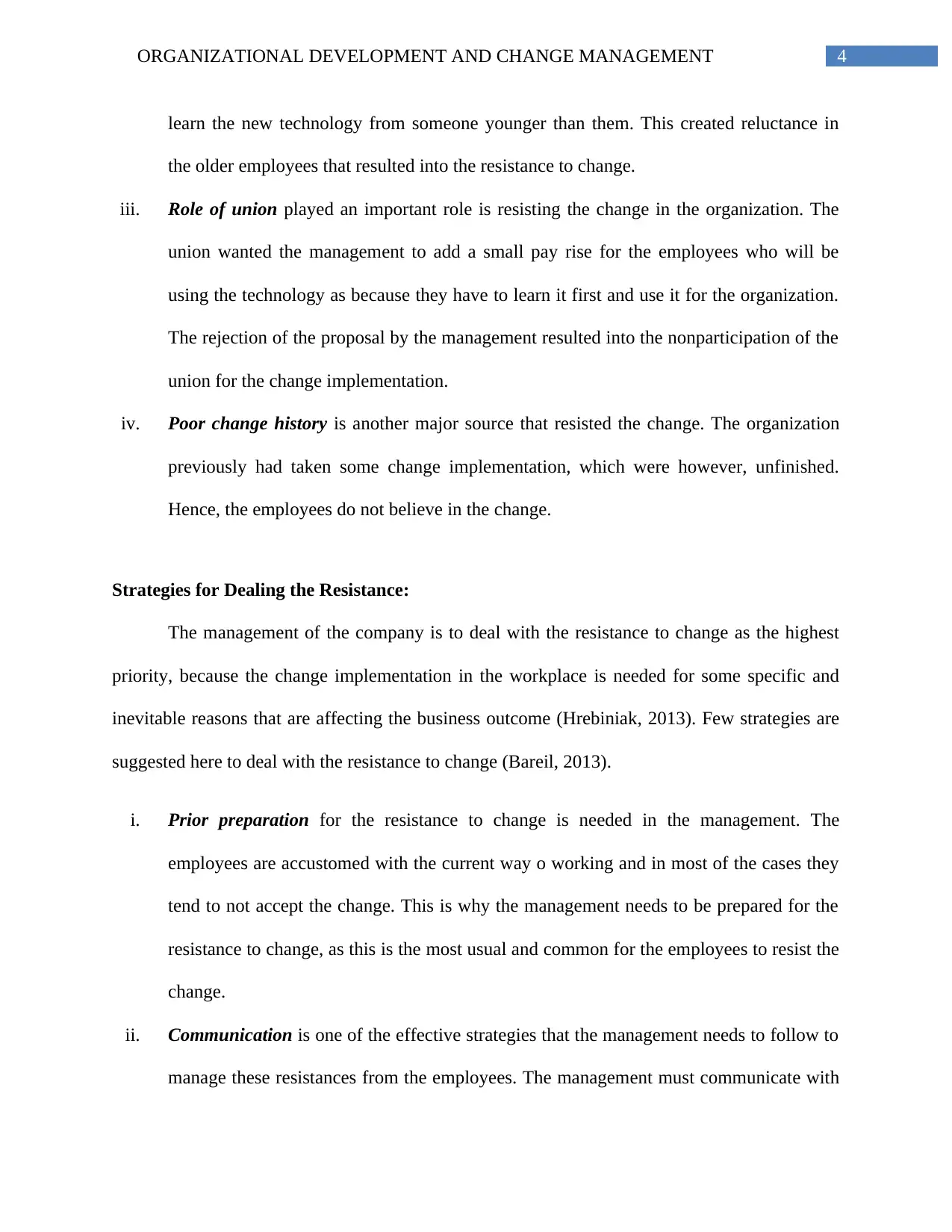
4ORGANIZATIONAL DEVELOPMENT AND CHANGE MANAGEMENT
learn the new technology from someone younger than them. This created reluctance in
the older employees that resulted into the resistance to change.
iii. Role of union played an important role is resisting the change in the organization. The
union wanted the management to add a small pay rise for the employees who will be
using the technology as because they have to learn it first and use it for the organization.
The rejection of the proposal by the management resulted into the nonparticipation of the
union for the change implementation.
iv. Poor change history is another major source that resisted the change. The organization
previously had taken some change implementation, which were however, unfinished.
Hence, the employees do not believe in the change.
Strategies for Dealing the Resistance:
The management of the company is to deal with the resistance to change as the highest
priority, because the change implementation in the workplace is needed for some specific and
inevitable reasons that are affecting the business outcome (Hrebiniak, 2013). Few strategies are
suggested here to deal with the resistance to change (Bareil, 2013).
i. Prior preparation for the resistance to change is needed in the management. The
employees are accustomed with the current way o working and in most of the cases they
tend to not accept the change. This is why the management needs to be prepared for the
resistance to change, as this is the most usual and common for the employees to resist the
change.
ii. Communication is one of the effective strategies that the management needs to follow to
manage these resistances from the employees. The management must communicate with
learn the new technology from someone younger than them. This created reluctance in
the older employees that resulted into the resistance to change.
iii. Role of union played an important role is resisting the change in the organization. The
union wanted the management to add a small pay rise for the employees who will be
using the technology as because they have to learn it first and use it for the organization.
The rejection of the proposal by the management resulted into the nonparticipation of the
union for the change implementation.
iv. Poor change history is another major source that resisted the change. The organization
previously had taken some change implementation, which were however, unfinished.
Hence, the employees do not believe in the change.
Strategies for Dealing the Resistance:
The management of the company is to deal with the resistance to change as the highest
priority, because the change implementation in the workplace is needed for some specific and
inevitable reasons that are affecting the business outcome (Hrebiniak, 2013). Few strategies are
suggested here to deal with the resistance to change (Bareil, 2013).
i. Prior preparation for the resistance to change is needed in the management. The
employees are accustomed with the current way o working and in most of the cases they
tend to not accept the change. This is why the management needs to be prepared for the
resistance to change, as this is the most usual and common for the employees to resist the
change.
ii. Communication is one of the effective strategies that the management needs to follow to
manage these resistances from the employees. The management must communicate with
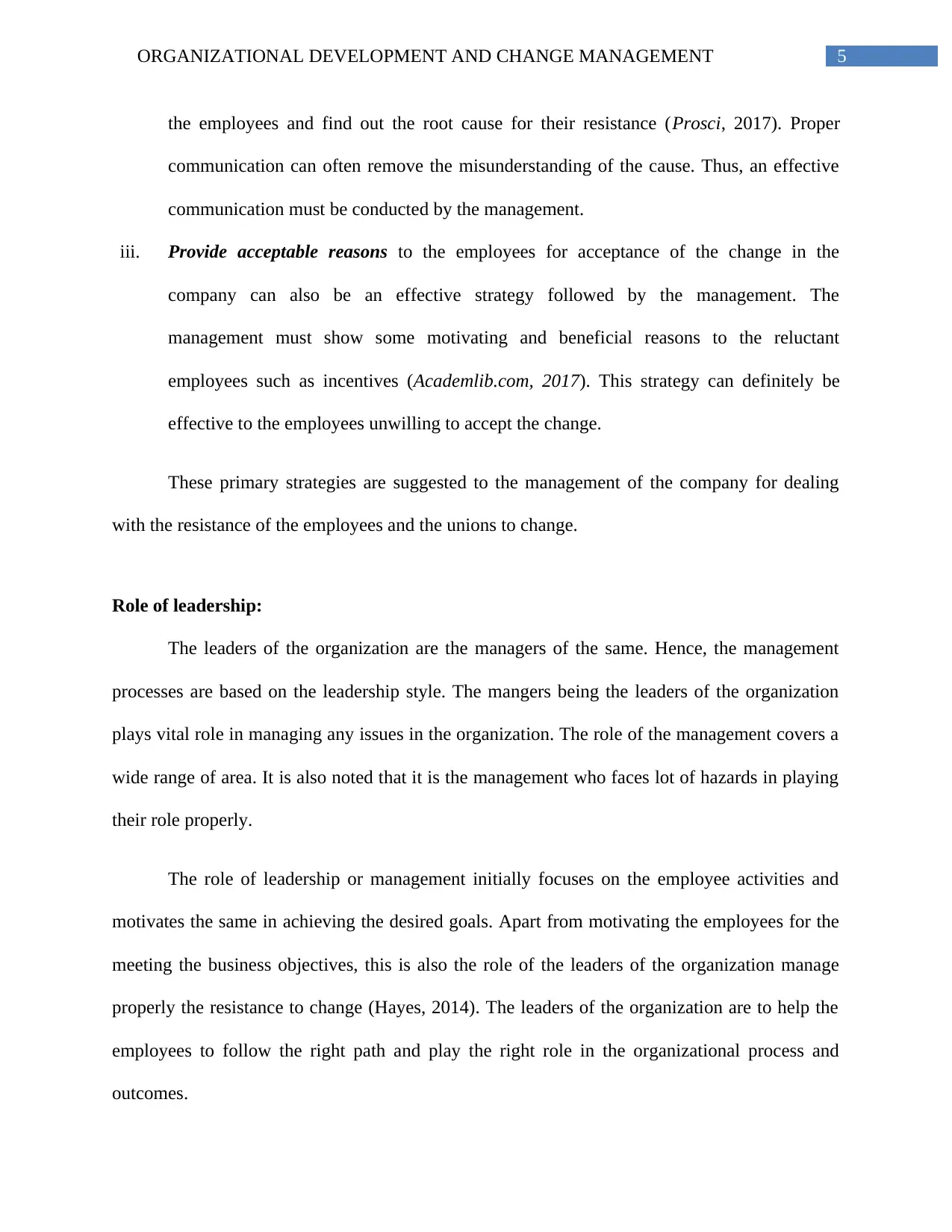
5ORGANIZATIONAL DEVELOPMENT AND CHANGE MANAGEMENT
the employees and find out the root cause for their resistance (Prosci, 2017). Proper
communication can often remove the misunderstanding of the cause. Thus, an effective
communication must be conducted by the management.
iii. Provide acceptable reasons to the employees for acceptance of the change in the
company can also be an effective strategy followed by the management. The
management must show some motivating and beneficial reasons to the reluctant
employees such as incentives (Academlib.com, 2017). This strategy can definitely be
effective to the employees unwilling to accept the change.
These primary strategies are suggested to the management of the company for dealing
with the resistance of the employees and the unions to change.
Role of leadership:
The leaders of the organization are the managers of the same. Hence, the management
processes are based on the leadership style. The mangers being the leaders of the organization
plays vital role in managing any issues in the organization. The role of the management covers a
wide range of area. It is also noted that it is the management who faces lot of hazards in playing
their role properly.
The role of leadership or management initially focuses on the employee activities and
motivates the same in achieving the desired goals. Apart from motivating the employees for the
meeting the business objectives, this is also the role of the leaders of the organization manage
properly the resistance to change (Hayes, 2014). The leaders of the organization are to help the
employees to follow the right path and play the right role in the organizational process and
outcomes.
the employees and find out the root cause for their resistance (Prosci, 2017). Proper
communication can often remove the misunderstanding of the cause. Thus, an effective
communication must be conducted by the management.
iii. Provide acceptable reasons to the employees for acceptance of the change in the
company can also be an effective strategy followed by the management. The
management must show some motivating and beneficial reasons to the reluctant
employees such as incentives (Academlib.com, 2017). This strategy can definitely be
effective to the employees unwilling to accept the change.
These primary strategies are suggested to the management of the company for dealing
with the resistance of the employees and the unions to change.
Role of leadership:
The leaders of the organization are the managers of the same. Hence, the management
processes are based on the leadership style. The mangers being the leaders of the organization
plays vital role in managing any issues in the organization. The role of the management covers a
wide range of area. It is also noted that it is the management who faces lot of hazards in playing
their role properly.
The role of leadership or management initially focuses on the employee activities and
motivates the same in achieving the desired goals. Apart from motivating the employees for the
meeting the business objectives, this is also the role of the leaders of the organization manage
properly the resistance to change (Hayes, 2014). The leaders of the organization are to help the
employees to follow the right path and play the right role in the organizational process and
outcomes.
⊘ This is a preview!⊘
Do you want full access?
Subscribe today to unlock all pages.

Trusted by 1+ million students worldwide
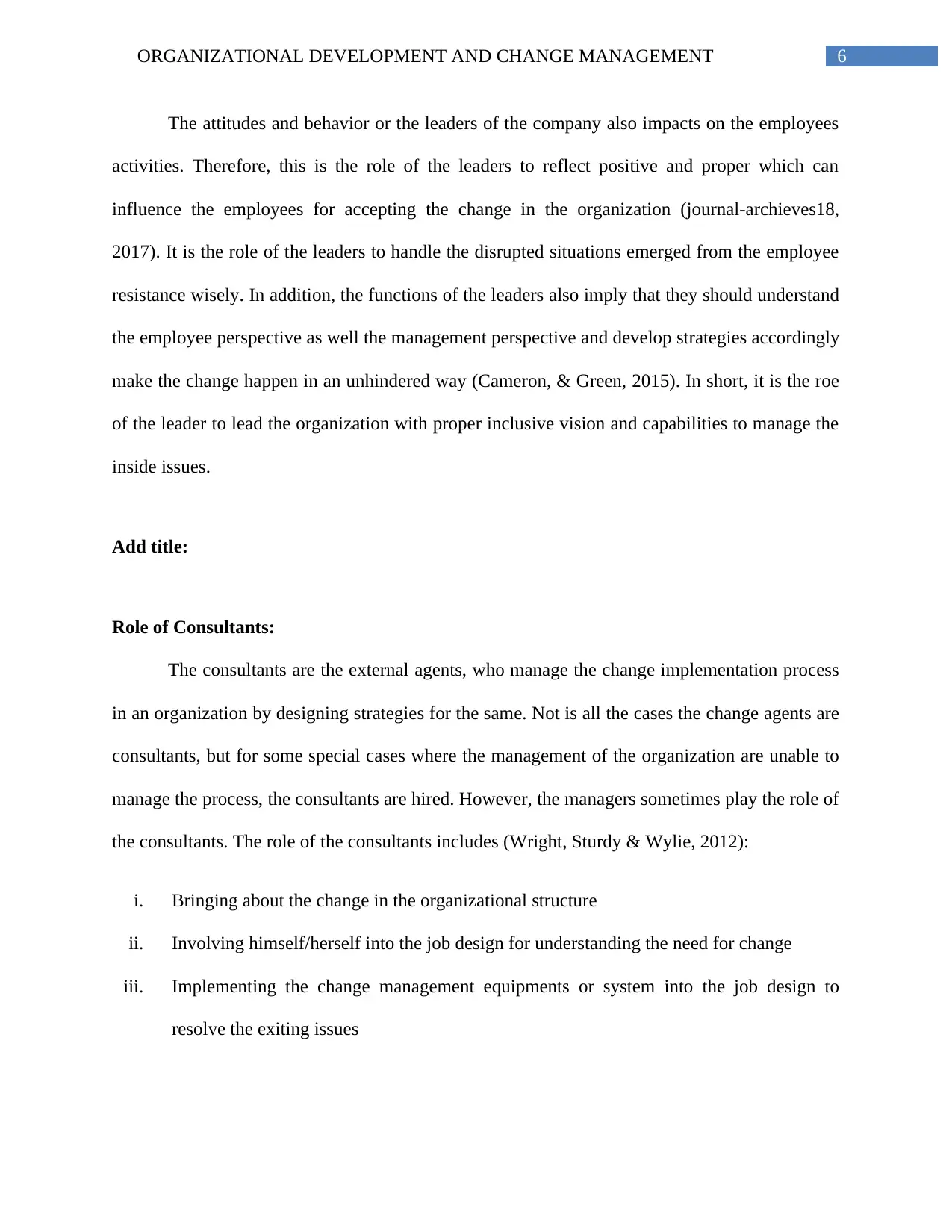
6ORGANIZATIONAL DEVELOPMENT AND CHANGE MANAGEMENT
The attitudes and behavior or the leaders of the company also impacts on the employees
activities. Therefore, this is the role of the leaders to reflect positive and proper which can
influence the employees for accepting the change in the organization (journal-archieves18,
2017). It is the role of the leaders to handle the disrupted situations emerged from the employee
resistance wisely. In addition, the functions of the leaders also imply that they should understand
the employee perspective as well the management perspective and develop strategies accordingly
make the change happen in an unhindered way (Cameron, & Green, 2015). In short, it is the roe
of the leader to lead the organization with proper inclusive vision and capabilities to manage the
inside issues.
Add title:
Role of Consultants:
The consultants are the external agents, who manage the change implementation process
in an organization by designing strategies for the same. Not is all the cases the change agents are
consultants, but for some special cases where the management of the organization are unable to
manage the process, the consultants are hired. However, the managers sometimes play the role of
the consultants. The role of the consultants includes (Wright, Sturdy & Wylie, 2012):
i. Bringing about the change in the organizational structure
ii. Involving himself/herself into the job design for understanding the need for change
iii. Implementing the change management equipments or system into the job design to
resolve the exiting issues
The attitudes and behavior or the leaders of the company also impacts on the employees
activities. Therefore, this is the role of the leaders to reflect positive and proper which can
influence the employees for accepting the change in the organization (journal-archieves18,
2017). It is the role of the leaders to handle the disrupted situations emerged from the employee
resistance wisely. In addition, the functions of the leaders also imply that they should understand
the employee perspective as well the management perspective and develop strategies accordingly
make the change happen in an unhindered way (Cameron, & Green, 2015). In short, it is the roe
of the leader to lead the organization with proper inclusive vision and capabilities to manage the
inside issues.
Add title:
Role of Consultants:
The consultants are the external agents, who manage the change implementation process
in an organization by designing strategies for the same. Not is all the cases the change agents are
consultants, but for some special cases where the management of the organization are unable to
manage the process, the consultants are hired. However, the managers sometimes play the role of
the consultants. The role of the consultants includes (Wright, Sturdy & Wylie, 2012):
i. Bringing about the change in the organizational structure
ii. Involving himself/herself into the job design for understanding the need for change
iii. Implementing the change management equipments or system into the job design to
resolve the exiting issues
Paraphrase This Document
Need a fresh take? Get an instant paraphrase of this document with our AI Paraphraser
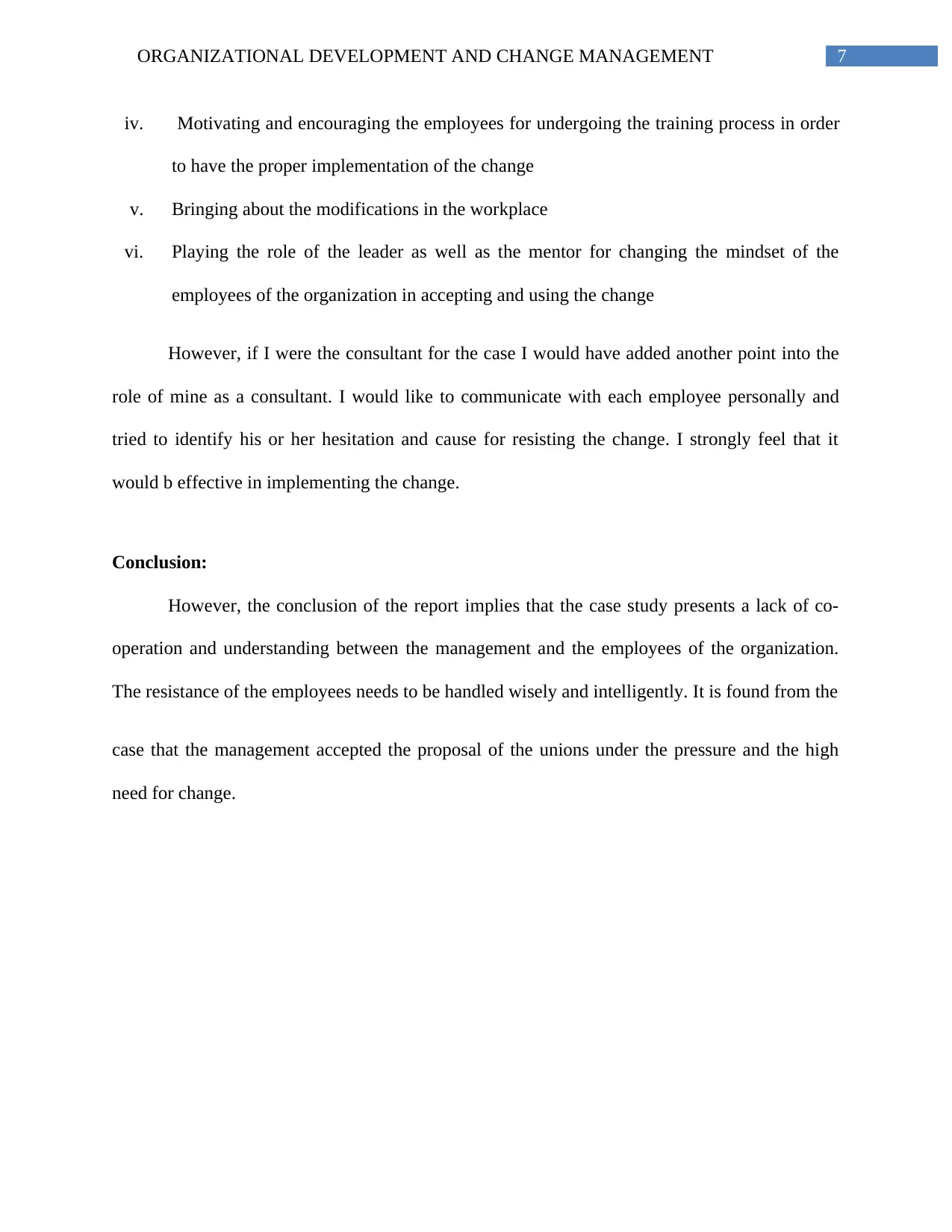
7ORGANIZATIONAL DEVELOPMENT AND CHANGE MANAGEMENT
iv. Motivating and encouraging the employees for undergoing the training process in order
to have the proper implementation of the change
v. Bringing about the modifications in the workplace
vi. Playing the role of the leader as well as the mentor for changing the mindset of the
employees of the organization in accepting and using the change
However, if I were the consultant for the case I would have added another point into the
role of mine as a consultant. I would like to communicate with each employee personally and
tried to identify his or her hesitation and cause for resisting the change. I strongly feel that it
would b effective in implementing the change.
Conclusion:
However, the conclusion of the report implies that the case study presents a lack of co-
operation and understanding between the management and the employees of the organization.
The resistance of the employees needs to be handled wisely and intelligently. It is found from the
case that the management accepted the proposal of the unions under the pressure and the high
need for change.
iv. Motivating and encouraging the employees for undergoing the training process in order
to have the proper implementation of the change
v. Bringing about the modifications in the workplace
vi. Playing the role of the leader as well as the mentor for changing the mindset of the
employees of the organization in accepting and using the change
However, if I were the consultant for the case I would have added another point into the
role of mine as a consultant. I would like to communicate with each employee personally and
tried to identify his or her hesitation and cause for resisting the change. I strongly feel that it
would b effective in implementing the change.
Conclusion:
However, the conclusion of the report implies that the case study presents a lack of co-
operation and understanding between the management and the employees of the organization.
The resistance of the employees needs to be handled wisely and intelligently. It is found from the
case that the management accepted the proposal of the unions under the pressure and the high
need for change.
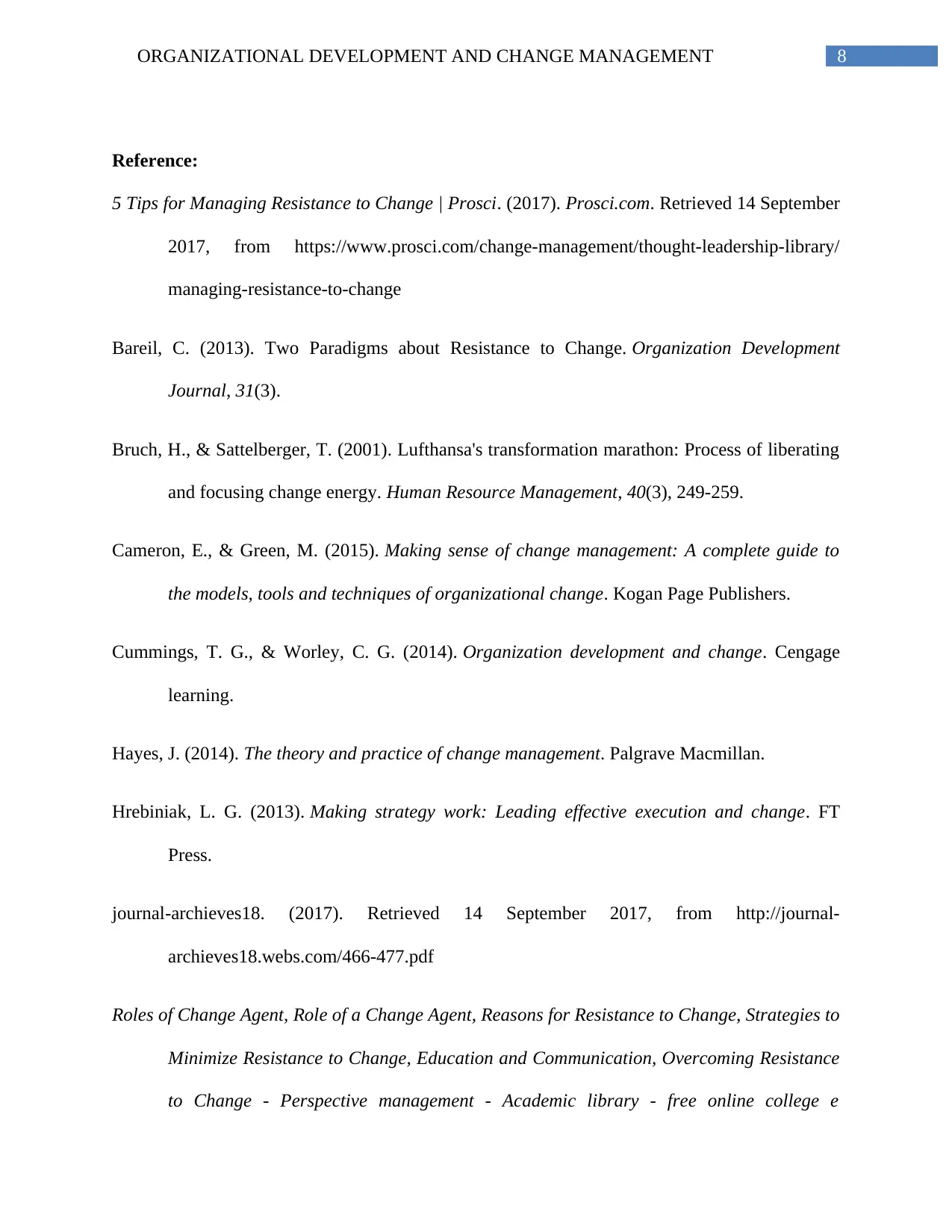
8ORGANIZATIONAL DEVELOPMENT AND CHANGE MANAGEMENT
Reference:
5 Tips for Managing Resistance to Change | Prosci. (2017). Prosci.com. Retrieved 14 September
2017, from https://www.prosci.com/change-management/thought-leadership-library/
managing-resistance-to-change
Bareil, C. (2013). Two Paradigms about Resistance to Change. Organization Development
Journal, 31(3).
Bruch, H., & Sattelberger, T. (2001). Lufthansa's transformation marathon: Process of liberating
and focusing change energy. Human Resource Management, 40(3), 249-259.
Cameron, E., & Green, M. (2015). Making sense of change management: A complete guide to
the models, tools and techniques of organizational change. Kogan Page Publishers.
Cummings, T. G., & Worley, C. G. (2014). Organization development and change. Cengage
learning.
Hayes, J. (2014). The theory and practice of change management. Palgrave Macmillan.
Hrebiniak, L. G. (2013). Making strategy work: Leading effective execution and change. FT
Press.
journal-archieves18. (2017). Retrieved 14 September 2017, from http://journal-
archieves18.webs.com/466-477.pdf
Roles of Change Agent, Role of a Change Agent, Reasons for Resistance to Change, Strategies to
Minimize Resistance to Change, Education and Communication, Overcoming Resistance
to Change - Perspective management - Academic library - free online college e
Reference:
5 Tips for Managing Resistance to Change | Prosci. (2017). Prosci.com. Retrieved 14 September
2017, from https://www.prosci.com/change-management/thought-leadership-library/
managing-resistance-to-change
Bareil, C. (2013). Two Paradigms about Resistance to Change. Organization Development
Journal, 31(3).
Bruch, H., & Sattelberger, T. (2001). Lufthansa's transformation marathon: Process of liberating
and focusing change energy. Human Resource Management, 40(3), 249-259.
Cameron, E., & Green, M. (2015). Making sense of change management: A complete guide to
the models, tools and techniques of organizational change. Kogan Page Publishers.
Cummings, T. G., & Worley, C. G. (2014). Organization development and change. Cengage
learning.
Hayes, J. (2014). The theory and practice of change management. Palgrave Macmillan.
Hrebiniak, L. G. (2013). Making strategy work: Leading effective execution and change. FT
Press.
journal-archieves18. (2017). Retrieved 14 September 2017, from http://journal-
archieves18.webs.com/466-477.pdf
Roles of Change Agent, Role of a Change Agent, Reasons for Resistance to Change, Strategies to
Minimize Resistance to Change, Education and Communication, Overcoming Resistance
to Change - Perspective management - Academic library - free online college e
⊘ This is a preview!⊘
Do you want full access?
Subscribe today to unlock all pages.

Trusted by 1+ million students worldwide
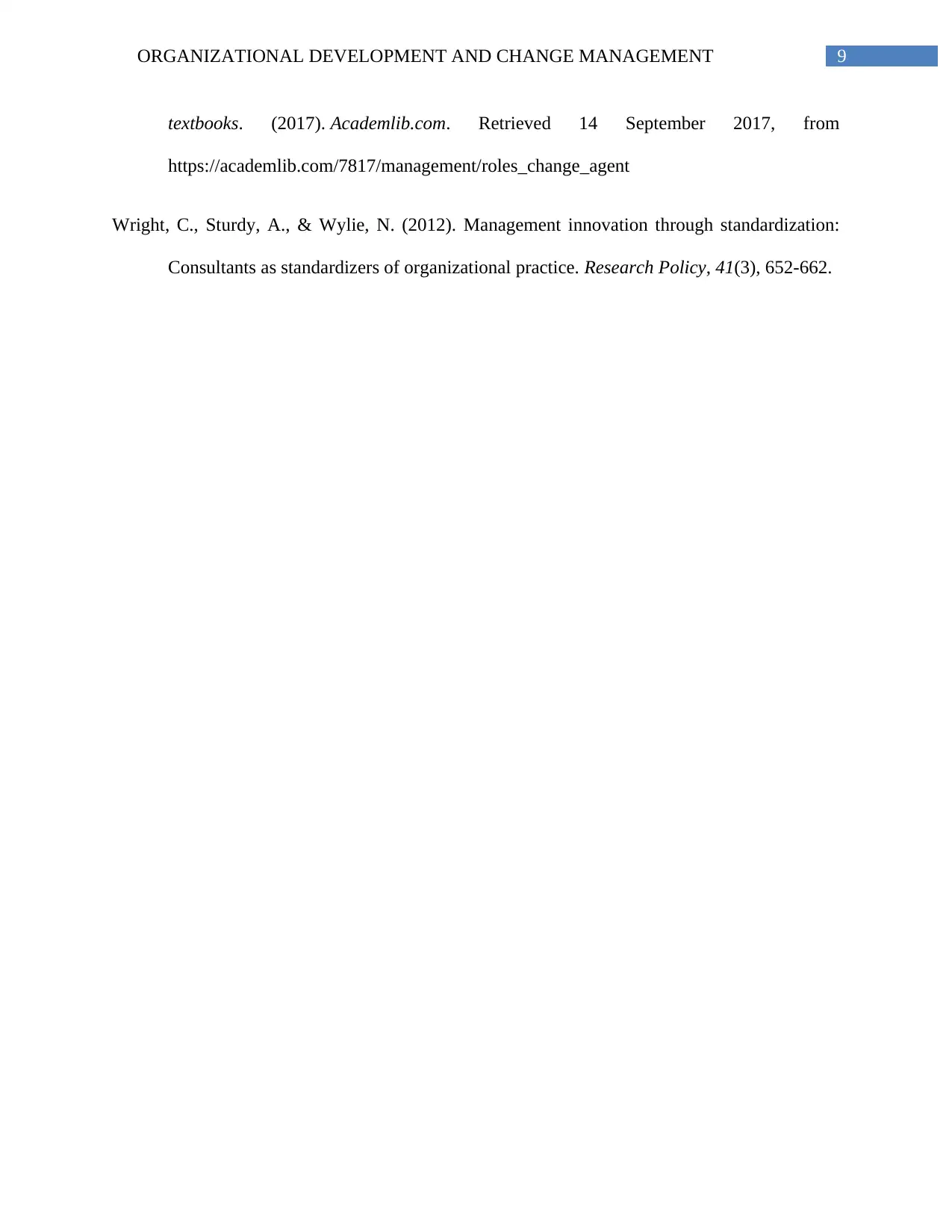
9ORGANIZATIONAL DEVELOPMENT AND CHANGE MANAGEMENT
textbooks. (2017). Academlib.com. Retrieved 14 September 2017, from
https://academlib.com/7817/management/roles_change_agent
Wright, C., Sturdy, A., & Wylie, N. (2012). Management innovation through standardization:
Consultants as standardizers of organizational practice. Research Policy, 41(3), 652-662.
textbooks. (2017). Academlib.com. Retrieved 14 September 2017, from
https://academlib.com/7817/management/roles_change_agent
Wright, C., Sturdy, A., & Wylie, N. (2012). Management innovation through standardization:
Consultants as standardizers of organizational practice. Research Policy, 41(3), 652-662.
1 out of 10
Related Documents
Your All-in-One AI-Powered Toolkit for Academic Success.
+13062052269
info@desklib.com
Available 24*7 on WhatsApp / Email
![[object Object]](/_next/static/media/star-bottom.7253800d.svg)
Unlock your academic potential
Copyright © 2020–2025 A2Z Services. All Rights Reserved. Developed and managed by ZUCOL.





